Frymaster FQE30 Service Manual
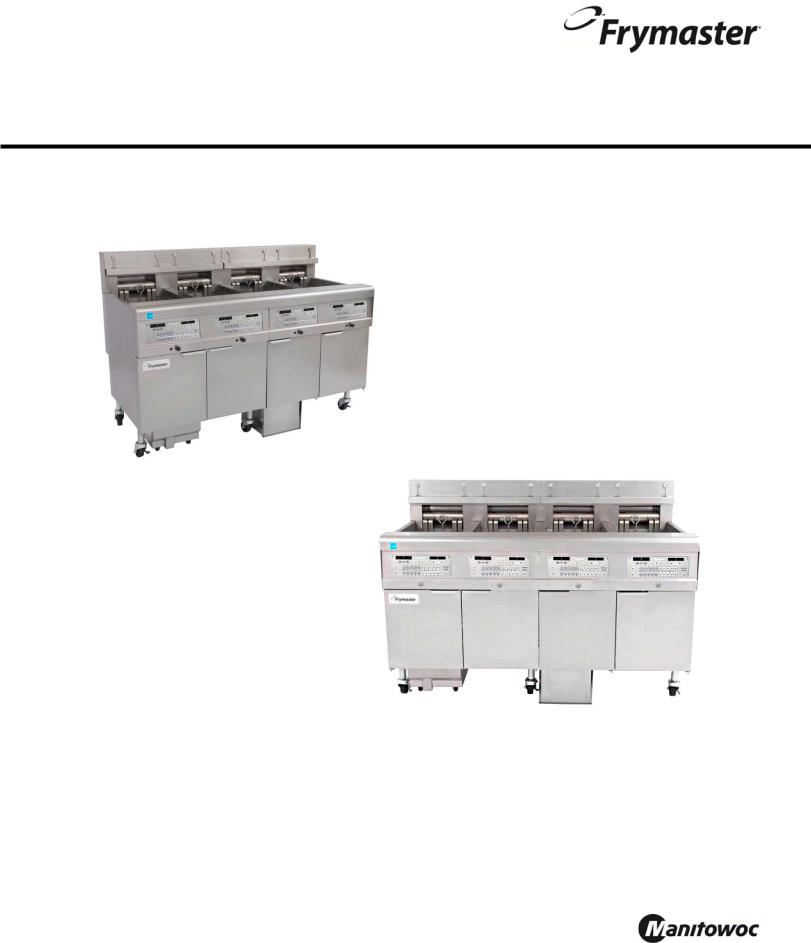
FilterQuick™ FQE30
Electric Fryer
Service Manual
This manual is updated as new information and models are released. Visit our website for the latest manual.
FOR YOUR SAFETY
Do Not Store or use gasoline or other flammable vapors and liquids in the vicinity of this or any other appliance.
*8197110*
Part Number: FRY_SM_8197110 09/2015
Original Instructions
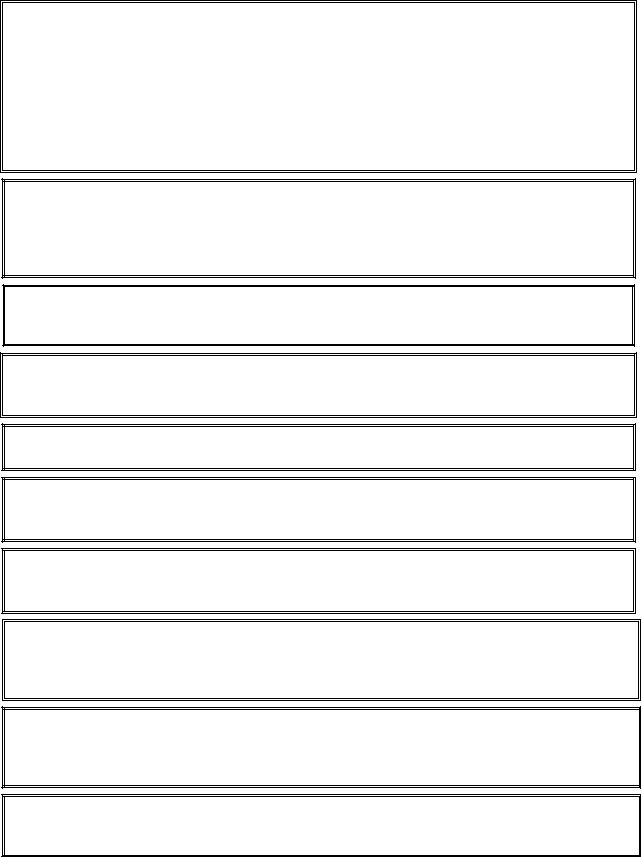
NOTICE
IF, DURING THE WARRANTY PERIOD, THE CUSTOMER USES A PART FOR THIS MANITOWOC FOOD SERVICE EQUIPMENT OTHER THAN AN UNMODIFIED NEW OR RECYCLED PART PURCHASED DIRECTLY FROM FRYMASTER, OR ANY OF ITS FACTORY AUTHORIZED SERVICERS, AND/OR THE PART BEING USED IS MODIFIED FROM ITS ORIGINAL CONFIGURATION, THIS WARRANTY WILL BE VOID. FURTHER, FRYMASTER DEAN AND ITS AFFILIATES WILL NOT BE LIABLE FOR ANY CLAIMS, DAMAGES OR EXPENSES INCURRED BY THE CUSTOMER WHICH ARISE DIRECTLY OR INDIRECTLY, IN WHOLE OR IN PART, DUE TO THE INSTALLATION OF ANY MODIFIED PART AND/OR PART RECEIVED FROM AN UNAUTHORIZED SERVICER.
NOTICE
This appliance is intended for professional use only and is to be operated by qualified personnel only. A Frymaster Authorized Servicer (FAS) or other qualified professional should perform installation, maintenance, and repairs. Installation, maintenance, or repairs by unqualified personnel may void the manufacturer’s warranty.
NOTICE
This equipment must be installed in accordance with the appropriate national and local codes of the country and/or region in which the appliance is installed.
 DANGER
DANGER
All wiring connections for this appliance must be made in accordance with the wiring diagrams furnished with the equipment. Wiring diagrams are located on the inside of the fryer door.
 DANGER
DANGER
Copper wire suitable for at least 167°F (75°C) must be used for power connections.
 DANGER
DANGER
The electrical power supply for this appliance must be the same as indicated on the rating and serial number plate located on the inside of the fryer door.
 DANGER
DANGER
This appliance must be connected to the voltage and phase as specified on the rating and serial number plate located on the inside of the fryer door.
NOTICE TO U.S. CUSTOMERS
This equipment is to be installed in compliance with the basic plumbing code of the Building Officials and Code Administrators International, Inc. (BOCA) and the Food Service Sanitation Manual of the U.S. Food and Drug Administration.
 DANGER
DANGER
Improper installation, adjustment, maintenance or service, and unauthorized alterations or modifications can cause property damage, injury, or death. Read the installation, operating, and service instructions thoroughly before installing or servicing this equipment.
 DANGER
DANGER
The front ledge of this appliance is not a step! Do not stand on the appliance. Serious injury can result from slips or contact with the hot oil.
ii
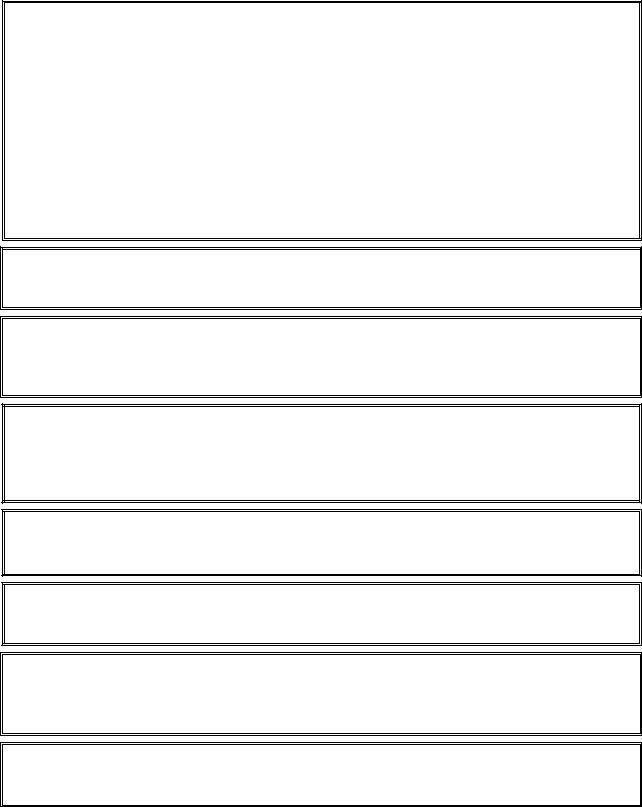
NOTICE TO OWNERS OF UNITS EQUIPPED WITH CONTROLLERS
U.S.
This device complies with Part 15 of the FCC rules. Operation is subject to the following two conditions: 1) This device may not cause harmful interference, and 2) This device must accept any interference received, including interference that may cause undesired operation. While this device is a verified Class A device, it has been shown to meet the Class B limits.
CANADA
This digital apparatus does not exceed the Class A or B limits for radio noise emissions as set out by the ICES-003 standard of the Canadian Department of Communications.
Cet appareil numerique n’emet pas de bruits radioelectriques depassany les limites de classe A et B prescrites dans la norme NMB-003 edictee par le Ministre des Communcations du Canada.
 DANGER
DANGER
Do not store or use gasoline or other flammable liquids or vapors in the vicinity of this or any other appliance.
 DANGER
DANGER
The crumb tray in fryers equipped with a filter system must be emptied into a fireproof container at the end of frying operations each day. Some food particles can spontaneously combust if left soaking in certain shortening material.
 WARNING
WARNING
Do not bang fry baskets or other utensils on the fryer’s joiner strip. The strip is present to seal the joint between the fry vessels. Banging fry baskets on the strip to dislodge shortening will distort the strip, adversely affecting its fit. It is designed for a tight fit and should only be removed for cleaning.
 WARNING
WARNING
Do not attach accessories to this fryer unless fryer is secured from tipping. Personal injury may result.
 WARNING
WARNING
This equipment is intended for indoor use only. Do not install or operate this equipment in outdoor areas.
 DANGER
DANGER
Adequate means must be provided to limit the movement of this appliance without depending on or transmitting stress to the electrical conduit. A restraint kit is provided with the fryer. If the restraint kit is missing contact your local KES.
 DANGER
DANGER
Prior to movement, testing, maintenance and any repair on your Frymaster fryer, disconnect all electrical power from the fryer.
iii

Table of Contents
Section 1: Service Procedures
CAUTIONARY STATEMENTS .................................................................................................................................................................. |
|
i |
||
ELECTRICAL POWER SPECIFICATIONS............................................................................................................................................. |
|
v |
||
1.1 |
General ................................................................................................................................................................................ |
|
1-1 |
|
|
1.1.1 |
Reading Model Numbers ................................................................................................................................ |
|
1-1 |
1.2 |
Replacing a Controller or Controller Wiring Harnesses....................................................................................... |
1-1 |
||
1.3 |
Replacing Component Box Components................................................................................................................ |
|
1-2 |
|
1.4 |
Replacing a High-Limit Thermostat........................................................................................................................... |
|
1-3 |
|
1.5 |
Replacing a Temperature Probe ................................................................................................................................. |
|
1-4 |
|
1.6 |
Replacing a Heating Element....................................................................................................................................... |
|
1-5 |
|
1.7 |
Replacing Contactor Box Components .................................................................................................................... |
|
1-7 |
|
1.8 |
Replacing a Frypot........................................................................................................................................................... |
|
1-9 |
|
1.9 |
Built-In Filtration System Service Procedures....................................................................................................... |
1-10 |
||
|
1.9.1 |
Filtration System Problem Resolution............................................................................................... |
1-10 |
|
|
1.9.2 |
Replacing the Filter Motor, Filter Pump and Related Components ........................................ |
1-11 |
|
|
1.9.3 |
Replacing the Filter Transformer or Filter Relay............................................................................. |
1-12 |
|
1.10 |
Basket Lift Service Procedures................................................................................................................................... |
|
1-14 |
|
1.11 |
ATO (Automatic Top-Off) Service Procedures...................................................................................................... |
1-14 |
||
|
1.11.1 ATO (Automatic Top-Off) Troubleshooting) ........................................................................................ |
1-15 |
||
|
1.11.2 ATO (Automatic Top-Off) Board Pin Positions and Harnesses....................................................... |
1-17 |
||
|
1.11.3 Replacing the ATO board, ATO Pump Relay or Transformer.......................................................... |
1-18 |
||
|
1.11.4 Replacing the ATO Pump or Solenoid.................................................................................................... |
1-18 |
||
1.12 |
MIB (Manual Interface Board) Service Procedures.............................................................................................. |
1-18 |
||
|
1.12.1 Manually Draining, Refilling or Filtering using the MIB board....................................................... |
1-19 |
||
|
1.12.2 MIB (Manual Interface Board) Troubleshooting.................................................................................. |
1-20 |
||
|
1.12.3 MIB (Manual Interface Board) Pin Positions and Harnesses............................................................ |
1-22 |
||
|
1.12.4 MIB (Manual Interface Board) Display Characters.............................................................................. |
1-23 |
||
|
1.12.5 Replacing the MIB Board ............................................................................................................................ |
|
1-23 |
|
|
1.12.6 Control Power Reset Switch ...................................................................................................................... |
|
1-23 |
|
1.13 |
Bulk Service Issues ......................................................................................................................................................... |
|
1-24 |
|
|
1.13.1 |
Bulk MIB Tests................................................................................................................................................. |
|
1-24 |
|
1.13.2 |
Bulk Wiring ...................................................................................................................................................... |
|
1-25 |
|
1.13.3 Bulk Oil System Plumbing Schematic .................................................................................................... |
1-26 |
||
|
1.13.4 Bulk Oil Test Quick Reference ................................................................................................................... |
|
1-26 |
|
1.14 |
AIF (Automatic Intermittent Filtration) Service Procedures ............................................................................ |
1-28 |
||
|
1.14.1 AIF (Automatic Intermittent Filtration) Troubleshooting................................................................ |
1-29 |
||
|
1.14.2 AIF (Automatic Intermittent Filtration) Actuator Board Pin Positions ........................................ |
1-30 |
||
|
1.14.3 Replacing an AIF (Automatic Intermittent Filtration) Board .......................................................... |
1-31 |
||
|
1.14.4 Replacing a Rotary Actuator...................................................................................................................... |
|
1-31 |
|
1.15 |
FilterQuick™ Controller Service Procedures ........................................................................................................... |
|
1-32 |
|
|
1.15.1 |
FilterQuick™ Controller Troubleshooting ............................................................................................... |
1-32 |
|
|
1.15.2 |
FilterQuick™ Controller Useful Codes ...................................................................................................... |
1-34 |
|
|
1.15.3 |
Service Required Errors ............................................................................................................................... |
|
1-35 |
|
1.15.4 |
Error Log Codes.............................................................................................................................................. |
|
1-36 |
|
1.15.5 |
FilterQuick™ Filter Error Flowchart............................................................................................................ |
|
1-37 |
|
1.15.6 |
Menu Trees...................................................................................................................................................... |
|
1-38 |
|
|
1.15.6.1 FilterQuick™ Controller Setup Menu Tree.......................................................................... |
1-38 |
|
|
|
1.15.6.2 FilterQuick™ Filter and Info Mode Menu Tree .................................................................. |
1-39 |
|
|
1.15.7 FilterQuick™ Controller Pin Positions and Harnesses ......................................................................... |
1-40 |
||
|
1.15.8 OQS (Oil Quality Sensor) Troubleshooting........................................................................................... |
1-41 |
||
1.16 |
Loading and Updating Software .............................................................................................................................. |
|
1-42 |
|
1.17 |
FilterQuick™ FQE Data Network Flowchart............................................................................................................. |
|
1-43 |
|
1.18 |
Interface Board Diagnostic Chart ............................................................................................................................. |
|
1-44 |
|
1.19 |
Probe Resistance Chart ................................................................................................................................................ |
|
1-45 |
|
Wiring Diagrams |
|
|
|
|
See 8197225 FilterQuick Elec Wiring Diagrams Manual |
|
|||
|
|
|
||
Part Number: Part Number: FRY_SM_8197110 |
iv |
|
||

ELECTRICAL POWER SPECIFICATIONS
|
|
Three (3) Phase Requirements |
|
|
||
MODEL |
kW |
VOLTAGE |
WIRE |
MINIMUM WIRE SIZE |
AMPS |
|
SERVICE |
AWG |
(mm) |
(per leg) |
|||
FQEL14 |
14 |
208 |
3 |
6 |
(4.11) |
39 |
FQEL14 |
14 |
240 |
3 |
6 |
(4.11) |
34 |
FQEL14 |
14 |
480 |
3 |
8 |
(2.59) |
17 |
FQEL14 |
14 |
220/380 |
4 |
6 |
(4.11) |
22 |
FQEL14 |
14 |
230/400 |
4 |
6 |
(4.11) |
21 |
FQEL14 |
14 |
240/415 |
4 |
6 |
(4.11) |
20 |
|
|
Single (1) Phase Requirements |
|
|
||
MODEL |
kW |
VOLTAGE |
WIRE |
MINIMUM WIRE SIZE |
AMPS |
|
SERVICE |
AWG |
(mm) |
(per leg) |
|||
FQEL14 |
14 |
208 |
2 |
3 |
(5.83) |
67 |
FQEL14 |
14 |
220 |
2 |
3 |
(5.83) |
63 |
FQEL14 |
14 |
240 |
2 |
4 |
(5.19) |
58 |
Part Number: Part Number: FRY_SM_8197110 |
v |
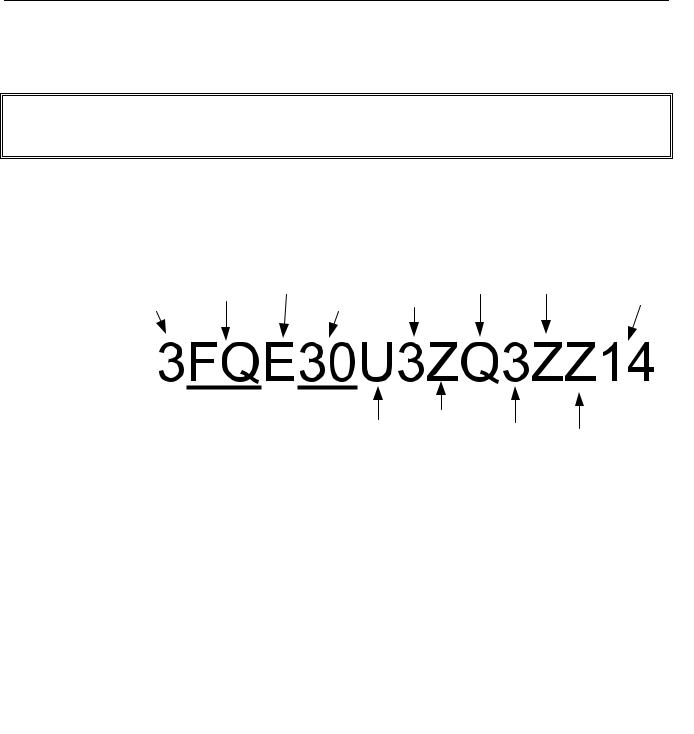
FILTERQUICK™ FQE30 SERIES ELECTRIC FRYERS
CHAPTER 1: SERVICE PROCEDURES
1.1 General
Before performing any maintenance on your Frymaster fryer, disconnect the fryer from the electrical power supply.
 WARNING
WARNING
To ensure the safe and efficient operation of the fryer, the electrical plug(s) must be fully engaged and locked in their pin and sleeve socket.
When electrical wires are disconnected, it is recommended that they be marked in such a way as to facilitate re-assembly.
1.1.1 Reading Model Numbers
1.2 Replacing the Controller or the Controller Wiring Harnesses
1.Disconnect the fryer from the electrical power supply.
2.Unscrew the filter push pull handle knobs.
3.Open the control panel by removing the screws on the bottom of the bezel. Carefully lower the bezel.
4.Remove the two screws from the upper corners of the controller. The controller is hinged at the bottom and will swing open from the top.
1-1

5.Unplug the wiring harnesses from the connectors on the back of the controller marking their position for reassembly and disconnect the grounding wires from the terminals. Remove the controller by lifting it from the hinged slots in the control panel frame.
Ground Wire Terminal |
Ground Wire Terminal |
|
20-Pin Connector |
|
Drain Switch |
Communication Wires |
and LED |
|
Locator Wire |
5.Install the replacement controller. Reinstall the control panel assembly by reversing steps 1 thru 5.
6.Setup the controller following the instructions on page 1-3 in the FilterQuick™ Controller Operation manual. Setup MUST be performed prior to readdress.
7.Once setup is complete on all replaced controllers, CYCLE POWER TO ENTIRE FRYER SYSTEM. See section 1.12.6 to reset control power.
8.Check software version and if necessary update the software. If a software update was necessary, follow the instructions to update the software in section 1.16.
1.3 Replacing Component Box Components
1.Disconnect the fryer from the electrical supply.
2.Drain cooking oil below the level of the probe or thermostat.
3.Unscrew the filter push pull handle knobs.
4.Open the control panel by removing the screws on the bottom of the bezel. Carefully lower the bezel.
5.Remove the top two screws in the upper corners of the controller.
6.Swing the controller out from the top and allow it to rest on its hinge tabs.
7.Disconnect the controller wiring harness and ground wire from the back of the controller and remove the controller by lifting it from the hinge slots in the control panel frame.
8.Disconnect the wiring from the component to be replaced, being sure to make a note of where each wire was connected.
9.Dismount the component to be replaced and install the new component, ensuring that any required spacers, insulation, washers, etc. are in place.
NOTE: If more room to work is required, the control panel frame assembly may be removed by removing the hex-head screws which secure it to the fryer cabinet (see illustration below). If this option is chosen, all controller assemblies must be removed per steps 1 thru 7 above. The cover plate, on the lower front of the component box, may also be removed to allow additional access if desired.
1-2
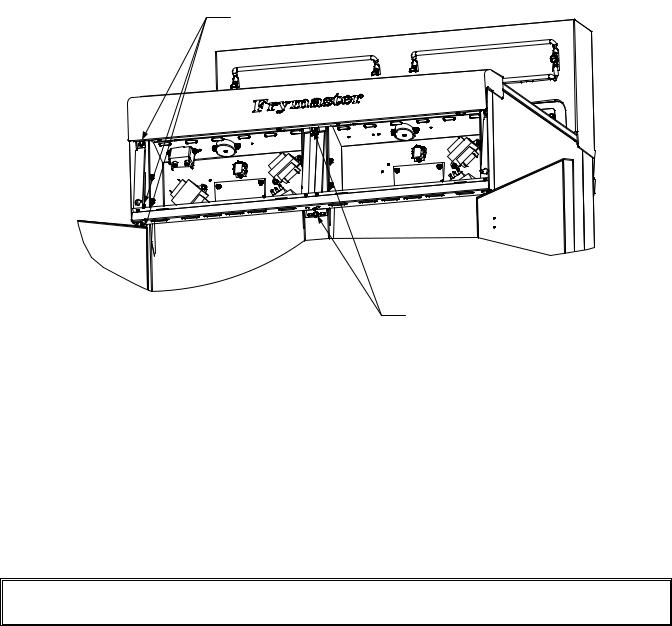
Remove these three |
screws at each end. |
Remove these two screws |
from the center supports. |
Removing the Control Panel Frame and Top Cap Assembly |
10.Reconnect the wiring disconnected in step 7, referring to your notes and the wiring diagrams on the fryer door to ensure that the connections are properly made. Also, verify that no other wiring was disconnected accidentally during the replacement process.
11.Reverse steps 1 through 8 to complete the replacement and return the fryer to service.
1.4 Replacing a High-Limit Thermostat
1.Remove the filter pan and lid from the unit. Drain the frypots into a Shortening Disposal Unit (SDU) or other appropriate METAL container using the controller “drain to pan option” or using the MIB board in manual mode.
 DANGER
DANGER
DO NOT drain more than one full frypot or two split frypots into the SDU at one time.
2.Disconnect the fryer from the electrical power supply and reposition it to gain access to the rear of the fryer.
3.Remove the four screws from both the left and right sides of the lower back panel.
4.Locate the high-limit that is being replaced and follow the two-black wires to the 12-pin connector C-6. Note where the leads are connected prior to removing them from the connector. Unplug the 12-pin connector C-6 and using a pin-pusher push the pins of the high-limit out of the connector.
5.Carefully unscrew the high-limit thermostat to be replaced.
6.Apply Loctite™ PST 567 or equivalent sealant to the threads of the replacement and screw it securely into the frypot.
7.Insert the leads into the 12-pin connector C-6 (see illustration below). For full-vat units or the left half of a dual-vat unit (as viewed from the rear of the fryer) the leads go into positions 1 and 2 of the connector. For the right half of a dual-vat unit (as viewed from the rear of the fryer), the leads go into positions 7 and 8. In either case, polarity does not matter.
1-3

8.Reconnect the 12-pin connecting plug C-6. Use wire ties to secure any loose wires.
9.Reinstall the back panels, contactor plug guards, reposition the fryer under the exhaust hood, and reconnect it to the electrical power supply to return the fryer to service.
1.5 Replacing a Temperature Probe
1.Lift the element out of the oil.
2.Disconnect the fryer from the electrical power supply and reposition it to gain access to the rear of the fryer.
3.Remove the four screws from both sides of the lower back panel. Then remove the two screws on both the left and right sides of the back of the tilt housing. Lift the tilt housing straight up to remove from the fryer.
4.Locate the red (or yellow) and white wires of the temperature probe to be replaced. Note where the leads are connected prior to removing them from the connector. Unplug the 12-pin connector C-6 and using a pin-pusher push the pins of the temperature probe out of the connector.
5.Remove the securing probe bracket and metal tie wraps that secure the probe to the element (see illustration below). Remove the ground clip on the probe shield.
Probe
Leads 




|
Probe |
Metal Wire Tie |
Bracket |
|
6.Gently pull on the temperature probe and grommet, pulling the wires up the rear of the fryer and through the element tube assembly.
7.Insert the replacement temperature probe (wires first) into the tube assembly ensuring that the grommet is in place. Secure the probe to the elements using the bracket which was removed in Step 5 and the metal tie wraps which were included in the replacement kit.
8.Route the probe wires out of the tube assembly following the element wires down the back of the fryer through the Heyco bushings to the 12-pin connector C-6. Secure the wires to the sheathing with wire ties. Attach the ground clip.
9.Insert the temperature probe leads into the 12-pin connector C-6 (see illustration below). For fullvat units or the right half of a dual-vat unit (as viewed from the rear of the fryer) the red (or yellow) lead goes into position 3 and the white lead into position 4 of the connector. For the left half of a dual-vat unit (as viewed from the rear of the fryer), the red (or yellow) lead goes into
1-4

position 9 and the white lead into position 10. NOTE: Right and left refer to the fryer as viewed from the rear.
10.Secure any loose wires with wire ties, making sure there is no interference with the movement of the springs. Rotate the elements up and down, making sure that movement is not restricted and that the wires are not pinched.
11.Reinstall the tilt housing, back panels and contactor plug guards. Reposition the fryer under the exhaust hood and reconnect it to the electrical power supply to return the fryer to service.
1.6Replacing a Heating Element
1.Perform steps 1-5 of section 1.5, Replacing a Temperature Probe.
2.Disconnect the wire harness containing the probe wiring, where the temperature probe is attached to the element being replaced. Using a pin pusher, disconnect the probe wires from the 12-pin connector.
3.In the rear of the fryer disconnect the 6-pin connector for the left element (as viewed from the front of the fryer) or the 9-pin connector for the right element from the contactor box. Press in on the tabs on each side of the connector while pulling outward on the free end to extend the connector and release the element leads (see photo below). Pull the leads out of the connector and out of the wire sleeving.
4.Raise the element to the full up position and support the elements.
5.Remove the hex head screws and nuts that secure the element to the tube assembly and pull the element out of the frypot. NOTE: The nuts inside the tube can be held and removed using the RE element tube nut spanner, PN# 2304028. Full-vat elements consist of two dual-vat elements clamped together. For full-vat units, remove the element clamps before removing the nuts and screws that secure the element to the tube assembly.
6.If applicable, recover the probe bracket and probe from the element being replaced and install them on the replacement element. Install the replacement element in the frypot, securing it with the
1-5
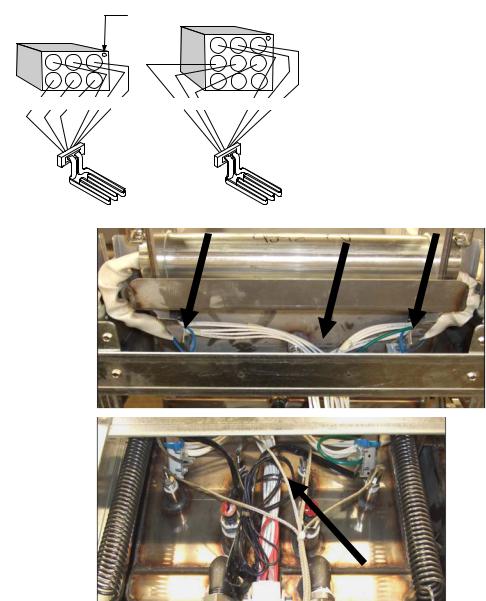
nuts and screws removed in Step 5 to the tube assembly. Ensure the gasket is between the tube and element assembly.
7.Route the element leads through the element tube assembly and into the wire sleeving to prevent chafing. Ensure that the wire sleeving is routed back through the Heyco bushing, keeping it clear from the lift springs (see phots below and on the next page). Also ensure that the wire sleeving extends into the tube assembly to protect the edge of the tube assembly from chafing the wires. Press the pins into the connector in accordance with the diagram below, and then close the connector to lock the leads in place. NOTE: It is critical that the wires be routed through the sleeving to prevent chafing.
|
|
|
|
|
Index Marker marks |
|
|
|
||
|
|
|
|
|
Position 1 |
|
|
|
|
|
|
|
|
|
|
|
|
3 |
2 |
1 |
|
|
3 |
2 |
1 |
|
|
|
6 |
5 |
4 |
|
|
6 |
5 |
4 |
|
|
|
9 |
8 |
7 |
|
6L |
5L |
4L |
3L 2L |
1L |
6 |
5 |
4R |
3R |
2 |
1R |
|
|
|
|
|
R |
R |
|
|
R |
|
Full vat element wire routing
Pull the element wires through the bushings on either side of the frypot and down the back. Element wires should be routed to the right of the ATO temperature probe on the back wall of the frypot.
Dual vat element wire routing
Pull the element wires through the bushings on either side of the frypot and down the back. Element wires should be routed to the center of the frypot between the ATO temperature probes.
1-6
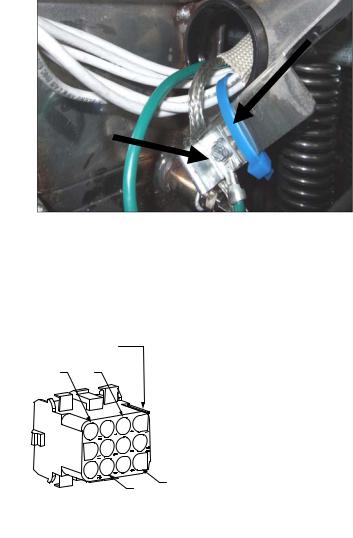
Element grounding and wire routing
To ground the element wires, use the hole in the frypot frame located under the bushing that the element wires pass through. Using a screw through the ground wires ring terminal, connect it to the frypot using the probe ground clip. Use a tie wrap to tie up half of the element wires after the wires are pulled through the bushing. Do not pull tie wrap tight, leave it slack at about one inch
8.Reconnect the element connector ensuring that the latches lock.
9.Insert the temperature probe leads into the 12-pin wiring harness connector (see illustration below). For full-vat units or the right half of a dual-vat unit, the red lead goes into position 3 and the white into position 4. For the left half of a dual-vat unit, the red lead goes into position 9 and the white into position 10. NOTE: Right and left refer to the fryer as viewed from the rear.
10.Reconnect the 12-pin connector of the wiring harness disconnected in Step 2.
11.Lower the element to the full down position.
12.Reinstall the tilt housing, back panels and contactor plug guard. Reposition the fryer under the exhaust hood, and reconnect it to the electrical power supply.
1.7Replacing Contactor Box Components
1.If replacing a contactor box component in boxes above the filter pan, first remove the filter pan and lid from the unit. If replacing components in fryers that have ATO boxes, the ATO box may require removal.
2.Disconnect the fryer from the electrical power supply.
3.Remove the two screws securing the cover of the contactor box. The contactor boxes above the filter pan are accessed by sliding under the fryer. They are located to the left and right above the guide rails (see photo below). The contactor boxes for frypots not over the filter pan are accessed by opening the fryer door directly under the affected frypot.
1-7
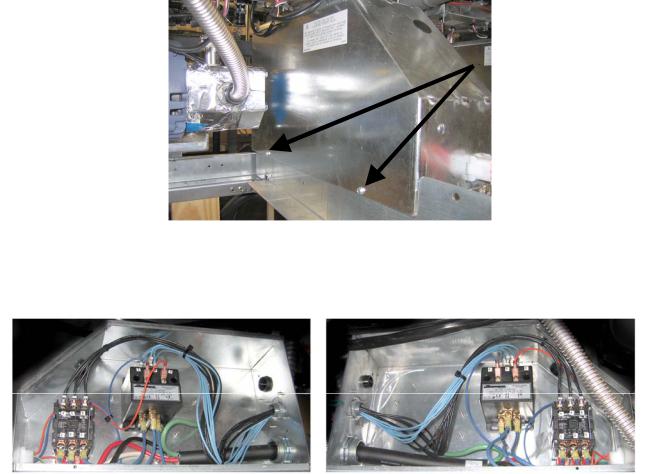
Remove two screws to access contactor box components above the
filter pan.
4.The contactors and relays are held on by threaded pin studs so that only removal of the nut is required to replace the component.
5.After performing necessary service, reverse steps 1-4 to return the fryer to operation.
Left and right views of mechanical contactor box components.
Sometimes it is necessary to remove the entire contactor box to repair. Below are the instructions for removing the far left contactor box.
1.Remove fryers from hood and remove all power to fryers.
2.Remove lower back panel.
3.Remove filter pan, lid and downspout splash shield.
4.Remove clevis clip from dispose handle at rear of fryer and let handle drop out of waste valve bracket.
5.Remove two screws holding waste valve handle at front of fryer and remove bracket and handle from fryer.
6.Remove AIF board and tuck wires out of the way of the contactor box for box removal.
7.Remove shipping brace that supports filter pump shelf brace to top of contactor box.
8.Remove contactor box cover.
9.Unplug all wiring from front and rear of contactor box.
10.Remove two screws that hold element wire shield to rear of contactor box and remove wire shield.
11.Remove two screws that support contactor box at rear of box.
12.Remove two screws that support contactor box at front of box.
13.Lift contactor box up to clear left frame rail and slide to the right far enough that the left rear corner of the pump and motor shelf protrude inside of the contactor box slightly.
14.Tip front of contactor box down and to the right slightly and then pull out from opening where filter pan lid would rest.
15.Reverse above steps for reinstallation.
1-8

1.8 Replacing a Frypot
1.Drain the frypot into the filter pan or, if replacing a frypot over the filter system, into a Shortening Disposal Unit (SDU) or other appropriate METAL container. If replacing a frypot over the filter system, remove the filter pan and lid from the unit.
 DANGER
DANGER
DO NOT drain more than one full frypot or two split frypots into the SDU at one time.
2.Disconnect the fryer from the electrical power supply and reposition it to gain access to both the front and rear.
3.Disconnect the fryer from the electrical supply.
4.Drain cooking oil below the level of the probe or thermostat.
5.Unscrew the filter push pull handle knobs.
6.Open the control panel by removing the screws on the bottom of the bezel. Carefully lower the bezel.
7.Remove the top two screws in the upper corners of the controller.
8.Swing the controller out from the top and allow it to rest on its hinge tabs.
9.Disconnect the controller wiring harness and ground wire from the back of the controller and remove the controller by lifting it from the hinge slots in the control panel frame (see illustration and photo on page 1-1).
10.Remove the controllers by lifting them from the hinge slots in the control panel frame.
11.Remove the tilt housing and back panels from the fryer. The tilt housing must be removed first in order to remove the upper back panel.
12.To remove the tilt housing, remove the hex-head screws from the rear edge of the housing. The housing can be lifted straight up and off the fryer.
13.Remove the control panel by removing the screw in the center and the nuts on both sides.
14.Loosen the component boxes by removing the screws, which secure them in the cabinet.
15.Dismount the top cap by removing the nuts at each end that secure it to the cabinetry.
16.Remove the hex head screw that secures the front of the frypot to the cabinet cross brace.
17.Remove the top-connecting strip that covers the joint with the adjacent frypot.
18.Unscrew the nut located on the front of each section of drain tube, and remove the tube assembly from the fryer.
19.Remove the actuators from the drain and return valves and disconnect the wiring.
20.Disconnect any auto filtration probes and auto top off sensors and wiring.
21.At the rear of the fryer, unplug the 12-pin connector C-6 and, using a pin pusher, disconnect the high-limit thermostat leads. Disconnect any other probe wiring.
22.Disconnect the oil return flexline(s).
23.Raise the elements to the “up” position and disconnect the element springs.
24.Remove the machine screws and nuts that secure the element tube assembly to the frypot. Carefully lift the element assembly from the frypot and secure it to the cross brace on the rear of the fryer with wire ties or tape.
25.Carefully lift the frypot from the fryer and place it upside down on a stable work surface.
26.Recover the drain valve(s), oil return flexline connection fitting(s), actuators, AIF boards and highlimit thermostat(s) from the frypot. Clean the threads and apply Loctite™ PST 567 or equivalent sealant to the threads of the recovered parts and install them in the replacement frypot.
27.Carefully lower the replacement frypot into the fryer. Reinstall the hex head screw removed in step 11 to attach the frypot to the fryer.
28.Position the element tube assembly in the frypot and reinstall the machine screws and nuts removed in step 24.
1-9
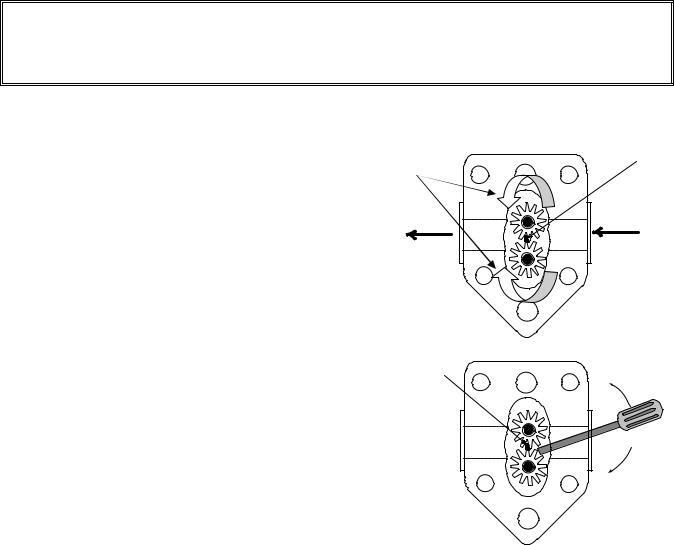
29.Reconnect the oil return flexlines to the frypot, and replace aluminum tape, if necessary, to secure heater strips to the flexlines.
30.Insert the high-limit thermostat leads disconnected in step 21 (see illustration on page 1-3 for pin positions).
31.Reconnect the actuators, ensuring the correct position of the drain and return valves.
32.Reconnect the auto filtration and auto top off probes.
33.Reinstall the drain tube assembly.
34.Reinstall the top connecting strips, top cap, tilt housing and back panels.
35.Reinstall controllers in the control panel frame and reconnect the wiring harnesses and ground wires.
36.Reposition the fryer under the exhaust hood and reconnect it to the electrical power supply.
1.9 Built-in Filtration System Service Procedures 1.9.1 Filtration System Problem Resolution
One of the most common causes of filtration problems is placing the filter pad/paper on the bottom of the filter pan rather than over the filter screen.
 CAUTION
CAUTION
Ensure that filter screen is in place prior to filter pad/paper placement and filter pump operation. Improper screen placement is the primary cause of filtration system malfunction.
Whenever the complaint is “the pump is running, but no oil is being filtered,” check the installation of the filter pad/paper, and ensure that the correct size is being used. While you are checking the filter pad/paper, verify that the O-rings on the pick-up tube
of the filter pan are in good condition. A missing or worn O-ring allows the pump to take in air and
decrease its efficiency.
If the pump motor overheats, the thermal overload will trip and the motor will not start until it is reset. If the pump motor does not start, press the red reset switch (button) located on the rear of the motor.
If the pump starts after resetting the thermal overload |
|
switch, then something is causing the motor to |
|
overheat. A major cause of overheating is when |
|
several frypots are filtered sequentially, overheating Sediment Particle |
Up for reverse |
the pump and motor. Allow the pump motor to cool |
|
at least 30 minutes before resuming operation. Pump |
|
overheating can be caused by: |
|
Solidified shortening in the pan or filter lines, or
Attempting to filter unheated oil or shortening (cold oil is more viscous, overloading the
pump motor and causing it to overheat).
1-10
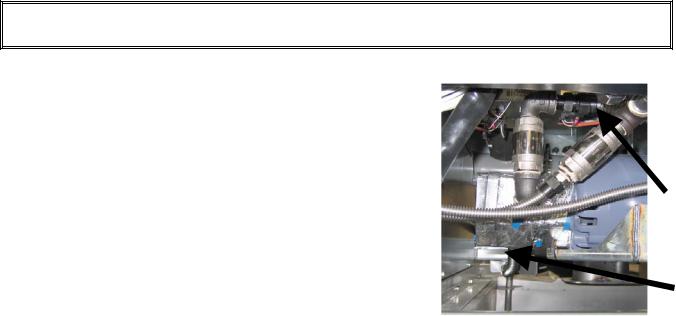
If the motor runs but the pump does not return oil, there is a blockage in the pump. Incorrectly sized or installed paper/pads will allow food particles and sediment to pass through the filter pan and into the pump. When sediment enters the pump, the gears bind, causing the motor to overload, again tripping the thermal overload. Shortening that has solidified in the pump will also cause it to seize, with the same result.
A pump seized by debris or hard shortening can usually be freed by manually moving the gears with a screwdriver or other instrument.
Disconnect power to the filter system, remove the input plumbing from the pump, and use a screwdriver to manually turn the gears.
●Turning the pump gears in reverse will release a hard particle.
●Turning the pump gears forward will push softer objects and solid shortening through the pump and allow free movement of the gears.
Incorrectly sized or installed paper/pads will also allow food particles and sediment to pass through and clog the suction tube on the bottom of the filter pan. Particles large enough to block the suction tube may indicate that the crumb tray is not being used. Pan blockage can also occur if shortening is left in the pan and allowed to solidify. Blockage removal can be accomplished by forcing the item out with an auger or drain snake. Compressed air or other pressurized gases should NEVER be used to force out the blockage.
1.9.2 Replacing the Filter Motor, Filter Pump, and Related Components
1.Remove the filter pan and lid from the unit. Drain the frypots into a Shortening Disposal Unit (SDU) or other appropriate metal container.
 DANGER
DANGER
DO NOT drain more than one full frypot or two split frypots into the SDU at one time.
2.Disconnect the fryer from the electrical power supply and reposition it to gain access to both the front and rear.
3.Disconnect the flexline running to the oil-return manifold at the rear of the fryer as well as the pump suction flexline at the end of the filter pan connection (see photo to the right).
4.Loosen the nut and bolt which secure the bridge to the oilreturn manifold.
5.Remove the cover plate from the front of the motor and disconnect the motor wires.
6.Remove the two nuts and bolts which secure the front of the bridge to the cross brace and carefully slide the bridge
rearward off the cross brace until its front end can be lowered to the floor. Undo the single nut holding it in place in back. Be careful not to let the rear of the bridge slip off the manifold at this point.
7. Get a good grip on the bridge, carefully pull it forward off the oil-return manifold, and lower the entire assembly to the
floor. Once on the floor, pull the assembly out the front of the fryer.
8. When required service has been completed, reverse steps 4-7 to reinstall the bridge.
1-11
